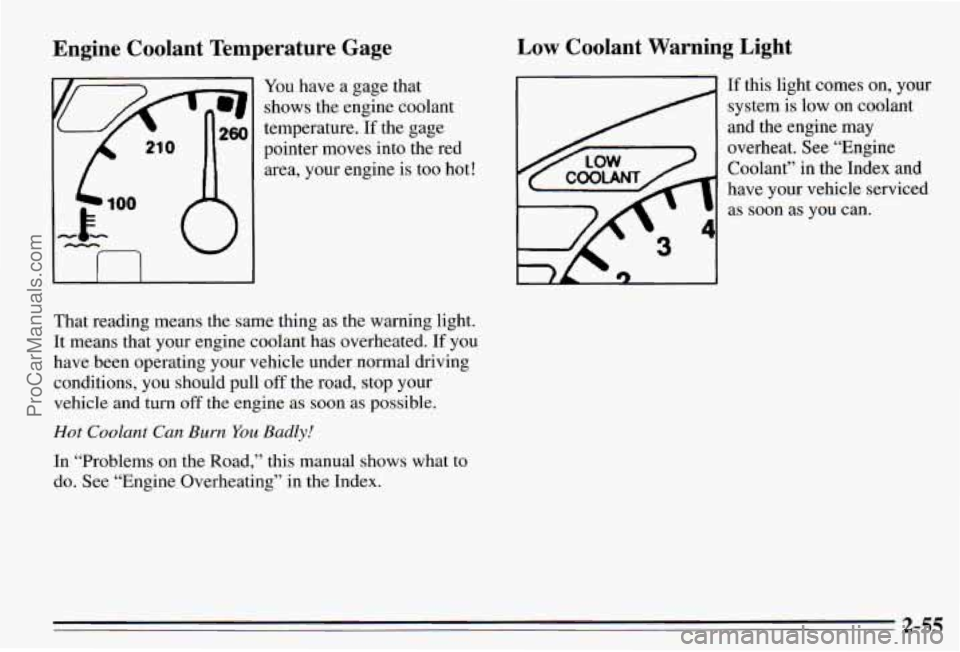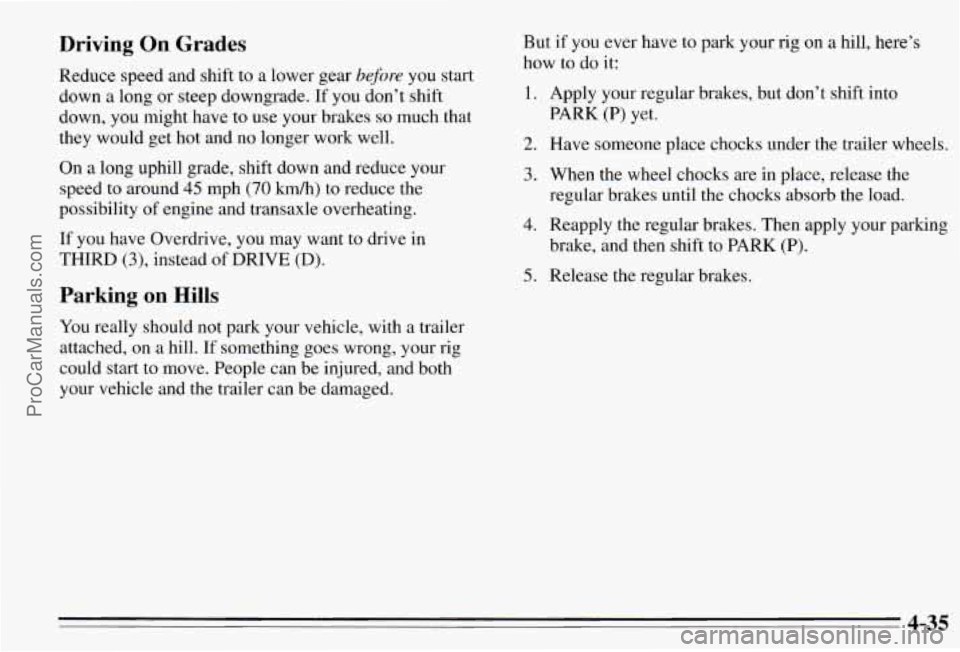1995 PONTIAC PONTIAC overheating
[x] Cancel search: overheatingPage 2 of 354

1995 Pontiac Grand Prix Owner’s Manual
Seats and Restraint Systems ...... F.-c-.,. ............................................... 1-1
This section tells you how to use your seats and safety belts prop\
erly. It also explains the “SRS” system.
Features and Controls ............................................................... 2-1
This section explains how to start and operate your Pontiac.
Comfort Controls and Audio Systems .................................................. 3-1
This section tells you how to adjust the ventilation and comfort controls and how to operate your
audio system.
YourDrivingandtheRoad ........................................................... 4-1
ProblernsontheRoad ............................................................... 5-1
Here you’ll find helpful information and tips about the road\
and how to drive under different conditions.
This section tells you what to
do if you have a problem while driving, such as a flat tire or engine
overheating, etc.
Here the manual tells you how to keep your Pontiac running properly and looking good.
This section tells you when to perform vehicle maintenance and \
what fluids and lubricants
to use.
This section tells you how to contact Pontiac for assistance and how to get service publications.
It
also gives you information on “Reporting Safety Defects” on pag\
e 8-4.
Here’s an alphabetical listing of almost every subject in this manual. You can use it to quickly find
something you want to read.
Service and Appearance Care.. ....................................................... 6-1
Maintenanceschedule ............................................................... 7-1
Customer Assistance Information ..................................................... 8-1
Index ........................................................................\
..... 9-1
i
ProCarManuals.com
Page 115 of 354

Anti-Lock Brake System Active Light
(Option)
When your anti-lock system
is adjusting brake pressure
to help avoid a braking skid,
the
LOW TRAC light will
come on.
Slippery road conditions will exist
if this light comes on,
so adjust your driving accordingly. The light will stay on
for a few seconds after the system stops adjusting brake
pressure.
The
LOW TRAC light also comes on briefly, as a bulb
check, when the engine is started. If the light doesn’t
come on then, have it fixed
so it will be there to tell you
when the system is active.
Engine Coolant Temperature Light
4b 100
This light tells you that
your engine coolant has
overheated
or your radiator
cooling fan is not working.
-k
If you have been operating your vehicle under normal
driving conditions, you should pull
off the road, stop
your vehicle and turn off the engine as soon as possible.
Hot Coolant Can Burn You Badly!
In “Problems on the Road,” this manual shows what to
do. See “Engine Overheating’’ in the Index.
2-54
ProCarManuals.com
Page 116 of 354

En.gine Coolant Temperature Gage
You have a gage that
shows the engine coolant
temperature.
If the gage
pointer moves into the red
area, your engine is too hot!
I I I I
That reading means the same thing as the warning light.
It means that your engine coolant has overheated. If you
have been operating your vehicle under normal driving
conditions, you should pull
off the road, stop your
vehicle and turn off the engine
as soon as possible.
Hot Coolant Can Burn You Badly!
In “Problems on the Road,” this manual shows what to
do. See “Engine Overheating” in the Index.
Low Coolant Warning Light
If this light comes on, your
system is low on coolant
and the engine may
overheat. See “Engine
Coolant” in the Index and
have your vehicle serviced as
soon as you can.
2-55
ProCarManuals.com
Page 178 of 354

Driving OR Grades
Reduce speed and shift to a lower gear before you start
down a long
or steep downgrade. If you don’t shift
down,
you might have to use your brakes so much that
they would get hot and no longer work well.
On a long uphill grade, shift down and reduce your
speed to around
45 mph (70 km/h) to reduce the
possibility
of engine and transaxle overheating.
If you have Overdrive,
you may want to drive in
THIRD (3), instead of DRIVE (D).
But if you ever have to park your rig on a hill, here’s
how to
do it:
1. Apply your regular brakes, but don’t shift into
PARK (P) yet.
2. Have someone place chocks under the trailer wheels.
3. When the wheel chocks are in place, release the
regular brakes until the chocks absorb the load.
4. Reapply the regular brakes. Then apply your parking
brake, and then shift to PARK (P).
5. Release the regular brakes.
Parking on Hills
You really should not park your vehicle, with a trailer
attached, on a hill.
If something goes wrong, your rig
could start to move. People can be injured, and both
your vehicle
and the trailer can be damaged.
ProCarManuals.com
Page 192 of 354

Engine Overheating
You will find a coolant temperature gage and a warning
light about a hot engine on your instrument panel. See
“Engine Coolant Temperature Gage” and “Engine
Coolant Temperature Warning Light” in the Index. You
also have a low coolant light on your instrument panel.
See “Low Coolant Light” in the Index.
If Steam Is Coming From Your Engine
NOTICE:
If your engine catches fire because you keep
driving with no coolant, your vehicle can be
badly damaged. The costly repairs would not
be covered by your warranty.
If No Steam Is Coming From Your Engine
If you get the overheat warning but see or hear no
steam, the problem may not be too serious. Sometimes
the engine can get
a little too hot when you:
Climb a long hill on a hot day.
Stop after high speed driving.
Idle for long periods in traffic.
Tow a trailer.
5-13
ProCarManuals.com
Page 195 of 354

If there seems to be no leak, with the engine on check to
see
if the electric engine fan(s) are running. If the engine
is overheating, both fan(s) should be running.
If they
aren’t,
your vehicle needs service.
How to Add Coolant to the Coolant
Recovery Tank
If you haven’t found a problem yet, but the coolant level
isn’t at the
COLD mark, add a 50/50 mixture of clean
water (preferably distilled) and a proper antifreeze at the
coolant recovery tank. (See “Engine Coolant”
in the
Index for more information about the proper coolant
mix.)
I I
NOTICE: I
Engine damage from runmng your engine
without coolant
isn’t covered by your warranty.
5-16
ProCarManuals.com
Page 232 of 354

Engine Coolant
The following explains your cooling system and how to
add coolant when it is low. If you have a problem with
engine overheating
or if you need to add coolant to your
radiator, see “Engine Overheating” in the Index.
The proper coolant for your Pontiac will:
Give freezing protection down to -34°F (-37°C).
Give boiling protection up to 262°F (128 “C).
0 Protect against rust and corrosion.
Help keep the proper engine temperature.
0 Let the warning lights work as they should.
What to Use
Use a mixture of one-half
clean water (preferably
distilled) and one-half antifreeze that meets “GM Specification 1825-M,” which won’t damage aluminum
parts. You can also use a recycled coolant conforming to
GM Specification 1825-M with
a complete coolant flush
and refill. Use GM Engine Coolant Supplement (sealer)
with any complete coolant flush and refill.
If you use
this mixture, you don’t need to add anything else.
I NOTICE:
If you use an improper coolant mix, your engine
could overheat and be badly damaged. The
repair cost wouldn’t be covered by your
warranty.
Too much water in the mix can freeze
and crack the engine, radiator, heater core and
other parts.
6-19 ProCarManuals.com
Page 235 of 354

Radiator Pressure Cap
NOTICE:
Your radiator cap is a 15 psi (105 kPa)
pressure-type cap and must be tightly installed
to prevent coolant loss and possible engine
damage from overheating. Be sure the arrows
on
the cap line up with the overflow tube on the
radiator filler neck.
When you replace your radiator pressure cap, an A@
cap is recommended.
Thermostat
Engine coolant temperature is controlled by a thermostat
in the engine coolant system. The thermostat stops the
flow
of coolant through the radiator until the coolant
reaches a preset temperature.
When you replace your thermostat, an
AC@ thermostat
is recommended.
Power Steering Fluid
3.1L L82 (Code M) Engine 3.4L LQl (Code X) Engine
How To Check Power Steering Fluid
When the engine compartment is cool, unscrew the cap
and wipe the dipstick with a clean rag. Replace the cap
and completely tighten it. Then remove the cap again
and look at the fluid level on the dipstick.
6-22
ProCarManuals.com